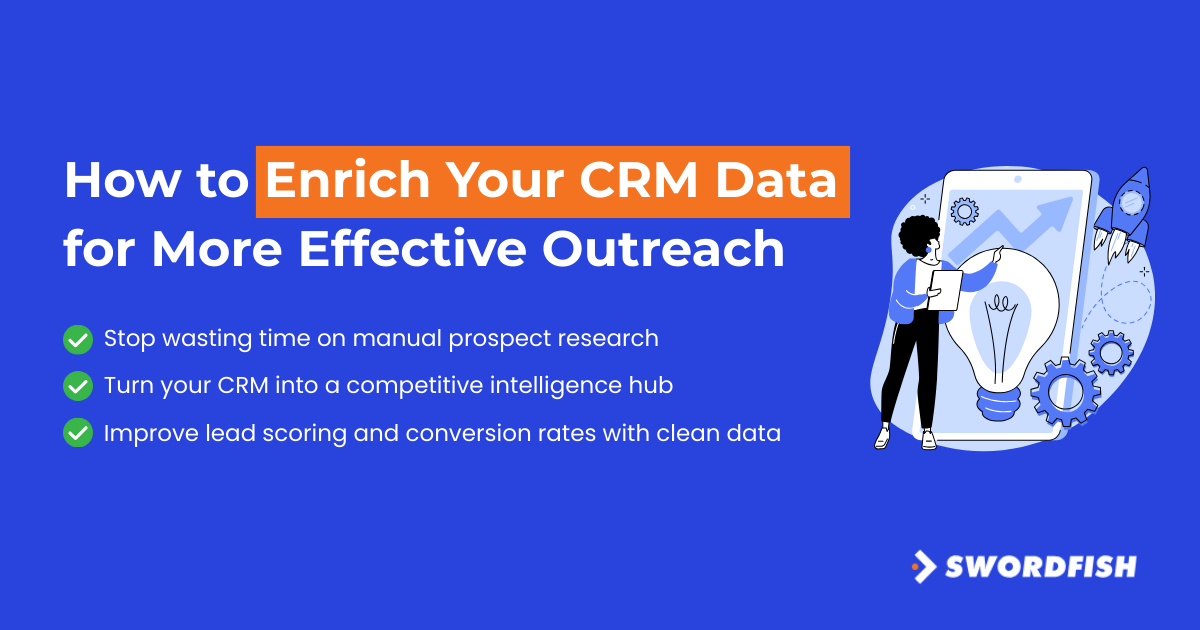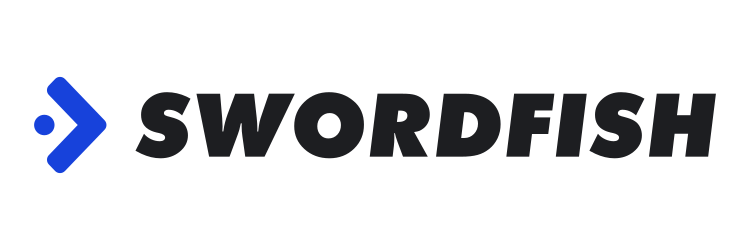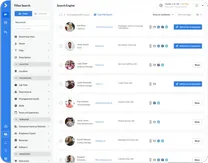 CRM data enrichment transforms incomplete contact records into revenue-generating assets by appending missing information like emails, phone numbers, job titles, and company data. Users of popular CRMs have reported an average increase of 25% in marketing return on investment (ROI) following the adoption of CRM solutions, while sales teams implementing a CRM system can experience an increase in lead conversion rates of up to 300%. The key to success lies in choosing between real-time vs. batch enrichment workflows, selecting the right tools (Apollo, Clearbit, Swordfish.ai), and measuring ROI through improved data accuracy and faster sales cycles.
CRM data enrichment transforms incomplete contact records into revenue-generating assets by appending missing information like emails, phone numbers, job titles, and company data. Users of popular CRMs have reported an average increase of 25% in marketing return on investment (ROI) following the adoption of CRM solutions, while sales teams implementing a CRM system can experience an increase in lead conversion rates of up to 300%. The key to success lies in choosing between real-time vs. batch enrichment workflows, selecting the right tools (Apollo, Clearbit, Swordfish.ai), and measuring ROI through improved data accuracy and faster sales cycles.
What is CRM Data Enrichment and Why It Matters for Sales Success
CRM data enrichment is the process of improving and expanding existing customer and prospect records by filling in missing information, updating outdated details, and adding valuable context that drives more effective outreach. Think of it as transforming a basic business card into a comprehensive customer profile that tells the complete story of who your prospects are and how to reach them effectively.
Enriched CRM data pulls from communication tools, social signals, calendars, and past touchpoints. It reveals buying committees, past conversations, and shared networks. This enhanced data becomes the foundation for personalized outreach, accurate lead scoring, and strategic account planning.
The Business Impact of Poor Data Quality
Consider this scenario: Your sales rep receives a hot lead from marketing, but the contact record only shows a name and company domain. No direct phone number, outdated job title, and missing decision-maker insights. That rep now faces a choice—spend hours researching manually or send a generic cold email that likely gets ignored.
A staggering 81% of IT leaders indicate that data silos are obstructing their digital transformation efforts, while sales teams report spending up to 40% of their time looking for prospects rather than actually selling. Clean, enriched data eliminates this waste.
Three Core Benefits of Enriching CRM Data
- Enhanced Lead Qualification and Scoring: Enriched data enables precision targeting. It gives your team insight into a lead’s industry, size, tech stack, buying signals, and role in the decision process. Instead of treating all leads equally, your team can prioritize high-fit prospects based on firmographic and technographic data.
- Personalized Outreach at Scale: When your CRM contains detailed job titles, recent company news, tech stack information, and direct contact details, your sales reps can craft personalized messages that resonate. This personalization directly impacts response rates and conversion quality.
- Faster Sales Cycles: Data accessibility for salespeople shortens their sales cycles by 8-14%. When reps have immediate access to validated contact information, decision-maker hierarchies, and buying signals, they can engage the right people at the right time with the right message.
Best Tools for Automatic CRM Data Enrichment
The CRM enrichment landscape offers various solutions, each with distinct strengths. Here’s how the leading platforms compare across key capabilities:
Clearbit (Now HubSpot Breeze Intelligence)
A premium choice for comprehensive firmographic and technographic enrichment, Clearbit pulls data from over 250 reliable sources. These include social profiles, company websites, legal filings, job boards, and crowdsourced inputs.
Key Strengths:
- Over 100 B2B attributes covering company size, industry, revenue, location, tech stack, job titles, and seniority levels
- Machine learning-powered data accuracy and verification
- Native HubSpot integration with real-time enrichment
Pricing and Limitations: Breeze Intelligence starts at $45/monthly for an annual commitment, or $50/monthly if you choose the monthly option. This gives you 100 Breeze Intelligence credits. However, contracts quickly reach 5 figures and can easily ramp to $80,000+ for large organizations, making it cost-prohibitive for many teams.
Best For: Enterprise teams with HubSpot already in place, complex technographic needs, and budget for premium data depth.
Apollo
Apollo combines enrichment with a full sales engagement platform, making it ideal for teams wanting an all-in-one solution. The platform offers both prospecting and data enhancement capabilities within a single workflow.
Key Strengths:
- Integrated prospecting, enrichment, and outreach
- Strong email and phone number coverage
- Built-in sequence automation and CRM sync
Considerations: Apollo can do a lot more than just data enrichment, so if you use it for sales prospecting, you’ll also be able to move leads through the pipeline, perform outreach, set up meetings, and close deals. However, this breadth might be overkill for teams focused solely on enrichment.
Swordfish.ai: The Smart Alternative
Swordfish.ai delivers exceptional value for teams prioritizing contact accuracy and global coverage. Unlike competitors focused primarily on firmographics, Swordfish.ai specializes in finding verified personal and business emails, cell phone numbers, and direct dials.
Core Advantages:
- Real-time validation: Both email and phone number connectivity verification
- Global coverage: 200+ live data partners ensuring comprehensive reach
- Flexible access: Chrome Extension, File Upload, Reverse Lookup, and API
- Compliance-first: GDPR and CCPA compliant with clear data handling policies
Pricing Transparency: Starting at $99/month for unlimited access (fair use policy), Swordfish.ai offers predictable costs without per-credit pricing that can spiral out of control.
Industry Results:
- Recruitment teams report 400% more cleared candidates
- Sales teams achieve 5x increase in connects
- Healthcare professionals access 11M+ provider contacts
Real-Time vs Batch Processing: Setting Up the Right Workflow
The choice between real-time and batch enrichment fundamentally shapes your sales operations and directly impacts lead response times and conversion rates.
Real-Time Enrichment: Speed-to-Lead Advantage
Real-time enrichment runs in the background continuously. As new leads are added to your CRM or as existing records change, enrichment tools automatically update missing fields, verify emails, flag inactive contacts.
When Real-Time Makes Sense:
- High-velocity inbound lead flow from marketing campaigns
- Form submissions requiring immediate qualification and routing
- Sales teams focused on speed-to-lead metrics
- Industries where contact information changes frequently (tech, startups)
Technical Requirements: Real-time workflows demand robust API connections, webhook configurations, and integration between your form capture, CRM, and enrichment provider. 75% of organizations will be using real-time data analytics by 2025, up from 30% in 2020.
Batch Processing: Efficiency at Scale
Batch enrichment is the traditional approach. You take a large set of contacts often monthly, quarterly, or during a big CRM overhaul and upload them to a third-party tool or vendor.
When Batch Processing Works Better:
- Periodic CRM hygiene and data cleaning projects
- Large volume uploads from trade shows or list purchases
- Longer sales cycles where immediate enrichment isn’t critical
- Budget-conscious teams preferring scheduled, controlled spending
Implementation Strategy: Batch processes collect customer data over time (i.e., over one day, one week, one year), ingest data points and unify them under customer profiles. Schedule these during off-peak hours to avoid system strain.
Hybrid Approaches: Best of Both Worlds
Leading revenue operations teams increasingly adopt hybrid models combining real-time enrichment for hot leads with batch processing for periodic data hygiene. Hybrid approaches combine the strengths of real-time and batch processing, offering a balanced solution for modern data challenges.
What Types of Data Should You Enrich
Strategic data enrichment requires focusing on fields that directly impact your sales process and customer understanding. Not all data points deliver equal value—prioritize based on your specific go-to-market motion.
Contact Information: The Foundation Layer
Personal and Business Emails: Verified email addresses form the backbone of modern sales outreach. Focus on tools that provide both personal and business emails with real-time validation to avoid bounce rates.
Direct Dial and Mobile Numbers: Speed matters in B2B. Enriched data enables precision targeting. Cell phone numbers and direct dials bypass gatekeepers and enable immediate connection with decision-makers.
Social Profiles: LinkedIn URLs, Twitter handles, and other social data enable social selling strategies and provide conversation starters for personalized outreach.
Company and Firmographic Data
Industry Classification: Detailed industry codes (NAICS, SIC) enable precise segmentation and industry-specific messaging. Look for tools offering granular classification beyond basic categories.
Company Size and Revenue: Employee count and revenue bands help sales teams prioritize accounts and tailor messaging appropriately for enterprise vs. SMB prospects.
Technology Stack: Understanding what tools and platforms prospects already use enables competitive positioning and integration-focused selling.
Behavioral and Intent Data
Recent Company News: Funding announcements, leadership changes, and expansion news provide timely conversation starters and urgency triggers for outreach.
Website Activity: For existing prospects, website behavior data reveals buying interest and engagement levels with your content.
Job Change Alerts: When contacts move to new companies, they often need to rebuild vendor relationships—creating immediate opportunities.
Advanced Enrichment Fields
Decision-Making Hierarchy: Understanding reporting structures and buying committees helps sales reps identify all stakeholders involved in purchase decisions.
Competitive Intelligence: Knowledge of current vendors and contract renewal dates enables strategic timing of outreach efforts.
Geographic Data: Precise location information supports territory management and time zone awareness for optimal outreach timing.
Measuring ROI and Effectiveness of Your CRM Enrichment Strategy
Successful CRM enrichment strategies require clear metrics and regular assessment to ensure data investments translate into revenue results. Here’s how leading sales organizations measure and optimize their enrichment ROI:
Primary Performance Indicators
Data Accuracy and Completeness Rates: Track the percentage of enriched records with valid, deliverable contact information. Aim for email deliverability rates above 95% and phone connectivity rates above 85%.
Speed-to-Lead Improvement: Measure time reduction from lead creation to first meaningful contact. This shortens sales cycles, reduces wasted effort, and drives higher close rates.
Response and Conversion Metrics: Compare response rates, meeting booking rates, and conversion percentages before and after implementing enrichment. Many teams see 2-3x improvement in initial response rates with properly enriched data.
Revenue Impact Measurement
Pipeline Velocity: Sales teams implementing a CRM system can experience an increase in lead conversion rates of up to 300%. Track how enrichment affects deal progression through pipeline stages.
Cost Per Acquisition: Calculate the total cost of enrichment tools and processes against the revenue generated from enriched leads. Factor in time savings for sales reps who spend less time researching prospects.
Account Penetration: For existing customers, measure how enrichment enables expansion into new departments or decision-makers within the same organization.
Operational Efficiency Gains
Sales Rep Productivity: Monitor time saved on manual research and data entry. Sales reps spend 40% of their time looking for prospects—enrichment should significantly reduce this waste.
Lead Qualification Accuracy: Track how well-enriched data improves initial lead scoring and qualification, reducing time spent on unqualified prospects.
CRM Data Health: Regular audits should show improved data completeness, reduced duplicates, and fewer outdated records over time.
Getting Started: Implementation Best Practices
Step 1: Audit Your Current Data State
Begin by examining your CRM data closely. Identify gaps like missing emails, outdated titles, or duplicate accounts. This audit reveals weak spots that hurt lead quality and sales productivity.
Run a comprehensive data quality assessment focusing on:
- Email deliverability rates across your database
- Percentage of records missing direct phone numbers
- Completeness of job titles and company information
- Duplicate contact and company records
Step 2: Define Clear Enrichment Goals
Know what you want from enrichment. Goals often include sharper lead targeting, lower email bounce rates, richer customer segmentation, or faster sales cycles.
Common objectives include:
- Reducing email bounce rates below 3%
- Achieving 90%+ completeness for critical fields (title, phone, industry)
- Enabling same-day response to high-priority inbound leads
- Supporting account-based marketing with detailed firmographics
Step 3: Choose Your Enrichment Stack
Map out your data supply chain. Use reputable third-party data vendors, social networks, and internal systems. Choose enrichment tools that plug into your CRM seamlessly, comply with GDPR and CCPA, and offer real-time updates.
Consider Swordfish.ai for teams prioritizing:
- High-accuracy contact information (emails and phone numbers)
- Global data coverage across industries
- Transparent, predictable pricing
- Quick implementation with Chrome Extension and API options
Step 4: Implement Data Hygiene Practices
Data hygiene is critical. Deduplicate records, fix errors, and standardize formats like phone numbers and job titles. Clean data avoids garbage-in-garbage-out problems and improves the accuracy of appended details.
Establish regular maintenance schedules:
- Weekly automated duplicate detection and merging
- Monthly validation of email addresses and phone numbers
- Quarterly comprehensive data audit and cleanup
Conclusion: Transform Your CRM Into a Revenue Engine
Enriching your CRM data isn’t just about filling in blank fields, it’s about transforming your sales process from reactive to proactive, from generic to personalized, and from time-consuming to efficient. When implemented correctly CRM can deliver a 245% return on investment.
The key to success lies in choosing the right combination of real-time and batch enrichment workflows, selecting tools that match your team’s specific needs and budget, and maintaining a consistent focus on data quality and hygiene.
For teams ready to see immediate results, Swordfish.ai offers the perfect combination of data accuracy, global coverage, and transparent pricing. With real-time email validation, verified phone numbers, and seamless CRM integration, you can transform incomplete prospect records into actionable sales opportunities.
Ready to enrich your CRM data and boost sales effectiveness? Try Swordfish.ai for free and discover why leading sales teams choose our platform for accurate, comprehensive contact data that drives real results.
About the Author
Ben Argeband is the Founder and CEO of Swordfish.ai and Heartbeat.ai. With deep expertise in data and SaaS, he has built two successful platforms trusted by over 50,000 sales and recruitment professionals. Ben’s mission is to help teams find direct contact information for hard-to-reach professionals and decision-makers, providing the shortest route to their next win. Connect with Ben on LinkedIn.


 View Products
View Products



